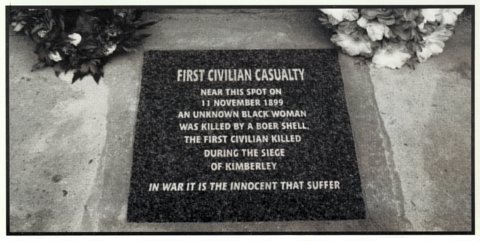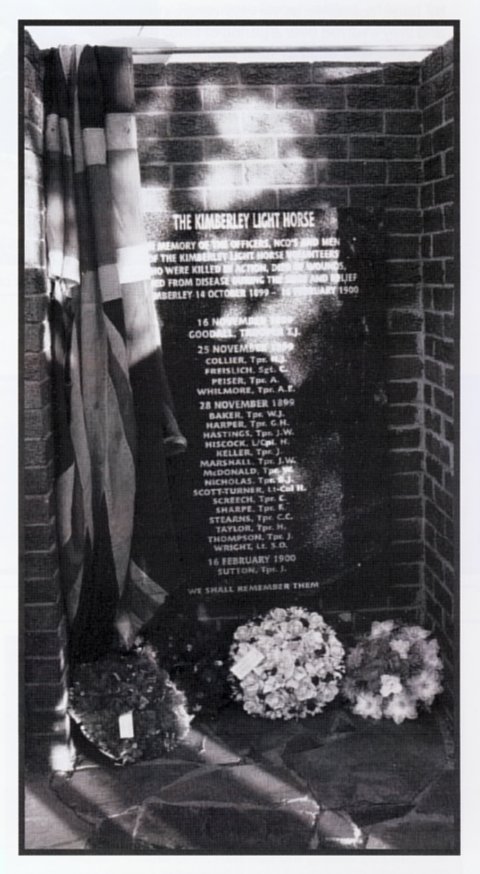

 The South African
The South African
The author is grateful to the South African Military History Society for the very kind donation that made possible the erection of the Kimberley Light Horse Memorial and the two smaller memorial tablets commemorating the Siege of Kimberley.
The Siege of Kimberley, 14 October 1899 to 15 February 1900, was commemorated in Kimberley over the weekend of 14 to 16 October 2011, with talks, tours and the unveiling of three memorials. The weekend began at 17.30 on Friday, 14 October, with the unveiling of a pavement memorial to the first civilian in Kimberley killed by Boer shell fire, an unknown black woman who died between the Catholic Cathedral and the Kimberley Club early on the morning of 11 November 1899.
The wording of the new memorial reads:
'FIRST CIVILIAN CASUALTY.
Near this spot on 11 November 1899 an unknown Black woman was killed by a Boer shell, the first civilian killed during the Siege of Kimberley.
In war it is the innocent that suffer.'

The unveiling of the memorial was followed, at 18.30 at the MOTH (Memorable Order of Tin Hats) Hall in Cassandra, by a talk by military historian Steve Lunderstedt on the actions of the Siege of Kimberley. This was followed by a meal with all proceeds going to the MOTHs.
The programme for Saturday, 15 October, included an all-day tour of the sites of the Siege of Kimberley, beginning at the McGregor Museum, which, at the time of the Siege, was the Kimberley Sanatorium, where Cecil Rhodes resided. All other sites, including the battlefield of Carter's Ridge, were visited during the course of the day. At 12.00, the second of the three memorials was unveiled. This was a headstone, in the Gladstone Cemetery, to the memory of Burgher Stephanus S Vivier of the Bloemfontein Commando. Burgher Vivier was wounded by a British lance on 16 February 1900, and succumbed to his wounds three days later in the Kimberley Hospital. After the completion of the day tour, the third memorial, dedicated to the Kimberley Light Horse, was unveiled in the MOTH Garden of Remembrance, next to the Honoured Dead Memorial Sacred Circle. This service began at 17.30.

The Saturday programme ended at the MOTH Hall Cassandra, where Steve Lunderstedt presented a paper on the involvement of black inhabitants during the Siege. All proceeds went to the MOTHs.
The final day, Sunday, 16 October, was open to all interested parties, who were invited to gather at 08.00 at the entrance to the Dronfield farm, some eight kilometres out of town on the Johannesburg Road. The visit included the sites of both of the Siege battles that took place on Dronfield on 24 October 1899 and 16 February 1900 respectively, and a talk was given. Tea, coffee and rusks were supplied and, after the tour, snacks were served to bring the commemorative weekend officially to a close.
On 13 October 1899, the afternoon before the Siege of Kimberley began, Lt-Col RG Kekewich requested permission from the High Commissioner, Sir Alfred Milner, based in Cape Town, to raise a unit of mounted horse. Given that there was only the mounted wing of the Kimberley Regiment (Diamond Fields Horse), a mounted wing of the Cape Police, and some mounted troops of the Loyal North Lancashire Regiment, the request was readily granted.
Lt-Col Henry Scott-Turner, the special staff officer sent to Kimberley from Rhodesia, whose idea it was, was gazetted officer in command and he set about raising the men needed for such an elite unit. Naturally enough, Scott-Turner's good friend Cecil Rhodes backed him, and it was he who donated the horses and kit necessary for such a venture. Rhodes, as a 'recruiting sergeant', found the unit some sterling men and, as just reward for his efforts, was appointed the Honorary Colonel of the Light Horse. The unit was known affectionately in Kimberley as 'Rhodes' Own' and 'Rhodes' Horse'.
Colonel Robert Scott VC and Captain G Harris, together with Scott-Turner, visited all the redoubts around Kimberley in search of volunteers. There were so many that it was easy to select only the best sort of recruit. By 19 October 1899, the 400-strong unit was in existence as a mobile and efficient mounted unit and, on 24 October, it received its baptism of fire in the action at Dronfield. The Kimberley Light Horse had been born and christened. The unit was to see action at both battles of Carter's Ridge in November and in numerous skirmishes throughout the defence of Kimberley, as well as the abortive chase for the Boer Long Tom on 16 February 1900.
After the Siege was lifted on 15 February 1900, the unit was represented in Colonel Mahon's Flying Column that successfully relieved besieged Mafeking as a part of the Kimberley Mounted Corps. Although disbanded shortly afterwards, the unit continued as part of the Kimberley Mounted Corps until the end of the war in May 1902. Many of the original members also joined Colonel Scott's Railway Guards.
The Kimberley Light Horse holds its head high as an elite unit in the colourful history of not just the Siege, but the history of Kimberley town.

Return to Journal Index OR Society's Home page
South African Military History Society / scribe@samilitaryhistory.org